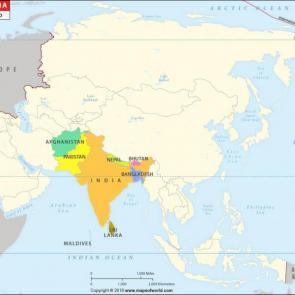جنوب آسیا کجاست؟ | نقشه جنوب آسیا
 آسیای جنوبی یا جنوب آسیا، بخش جنوبی قارهٔ آسیا است که شامل کشورهای جنوب کوههای هیمالیا (sub-Himalayan countries) و در برخی منابع معتبر (چون تعریف سازمان ملل) نیز همچنین شامل کشورهای مجاور در شرق و غرب آن نیز میشود. این منطقه (از غرب به شرق) توسط آسیای غربی، آسیای مرکزی، آسیای شرقی، و آسیای جنوب شرقی احاطه شدهاست.
آسیای جنوبی یا جنوب آسیا، بخش جنوبی قارهٔ آسیا است که شامل کشورهای جنوب کوههای هیمالیا (sub-Himalayan countries) و در برخی منابع معتبر (چون تعریف سازمان ملل) نیز همچنین شامل کشورهای مجاور در شرق و غرب آن نیز میشود. این منطقه (از غرب به شرق) توسط آسیای غربی، آسیای مرکزی، آسیای شرقی، و آسیای جنوب شرقی احاطه شدهاست.امروزه معمولاً شامل افغانستان، هند، پاکستان، بنگلادش، مالدیو، سریلانکا، و نپال. همه این کشورها اعضای سارک هستند.
برای نخستین بار پارچه پنبهای در حدود ۱٬۹۰۰ پیش از میلاد توسط تمدن دره سند در آسیای جنوبی بافته شد.

نقشه جنوب آسیا | South Asia Map, Map of South Asian Countries
برای بزرگنمایی و دانلود تصویر کلیک کنید.
South Asia or Southern Asia, is the southern region of the Asian continent, which comprises the sub-Himalayan countries and, for some authorities, adjoining countries to the west and east. Topographically, it is dominated by the Indian Plate, which rises above sea level as northern parts of India south of the Himalayas and the Hindu Kush. South Asia is bounded on the south by the Indian Ocean and on land (clockwise, from west) by Western Asia, Central Asia, East Asia and Southeast Asia.
The current territories of Afghanistan, Bangladesh, Bhutan, Maldives, Nepal, India, Pakistan and Sri Lanka form South Asia. The South Asian Association for Regional Cooperation (SAARC) is an economic cooperation organisation in the region which was established in 1985 and includes all eight nations comprising South Asia.
South Asia covers about 5.2 million km2 (2.0 million sq mi), which is 11.71% of the Asian continent or 3.5% of the world"s land surface area. The population of South Asia is about 1.891 billion or about one-fourth of the world"s population, making it both the most populous and the most densely populated geographical region in the world. Overall, it accounts for about 39.49% of Asia"s population, over 24% of the world"s population, and is home to a vast array of people.
In 2010, South Asia had the world"s largest populations of Hindus, Muslims, Sikhs, Jains and Zoroastrians. South Asia alone accounts for 98.47% population of global Hindus, 90.5% of global Sikhs, 31% of global Muslims, 35 million Christians and 25 million Buddhists.
History
Ancient era
The history of core South Asia begins with evidence of human activity of Homo sapiens, as long as 75,000 years ago, or with earlier hominids including Homo erectus from about 500,000 years ago. The Indus Valley Civilization, which spread and flourished in the northwestern part of South Asia from c. 3300 to 1300 BCE in present-day Pakistan, India and Afghanistan, was the first major civilization in South Asia. A sophisticated and technologically advanced urban culture developed in the Mature Harappan period, from 2600 to 1900 BCE.
The earliest prehistoric culture have roots in the mesolithic sites as evidenced by the rock paintings of Bhimbetka rock shelters dating to a period of 30,000 BCE or older, as well as neolithic times. According to anthropologist Possehl, the Indus Valley Civilization provides a logical, if somewhat arbitrary, starting point for South Asian religions, but these links from the Indus religion to later-day South Asian traditions are subject to scholarly dispute.
The Trimurti is the trinity of supreme divinity in Hinduism, typically Brahma the creator, Vishnu the preserver, and Shiva the destroyer
The Vedic period, named after the Vedic religion of the Indo-Aryans, lasted from c. 1900 to 500 BCE. The Indo-Aryans were pastoralists who migrated into north-western India after the collapse of the Indus Valley Civilization, Linguistic and archaeological data show a cultural change after 1500 BCE, with the linguistic and religious data clearly showing links with Indo-European languages and religion. By about 1200 BCE, the Vedic culture and agrarian lifestyle was established in the northwest and northern Gangetic plain of South Asia. Rudimentary state-forms appeared, of which the Kuru-Pañcāla union was the most influential. The first recorded state-level society in South Asia existed around 1000 BCE. In this period, states Samuel, emerged the Brahmana and Aranyaka layers of Vedic texts, which merged into the earliest Upanishads. These texts began to ask the meaning of a ritual, adding increasing levels of philosophical and metaphysical speculation, or "Hindu synthesis".
Increasing urbanisation of India between 800 and 400 BCE, and possibly the spread of urban diseases, contributed to the rise of ascetic movements and of new ideas which challenged the orthodox Brahmanism. These ideas led to Sramana movements, of which Mahavira (c. 549–477 BCE), proponent of Jainism, and Buddha (c. 563-483), founder of Buddhism, were the most prominent icons.
The Greek army led by Alexander the Great stayed in the Hindu Kush region of South Asia for several years and then later moved into the Indus valley region. Later, the Maurya Empire extended over much of South Asia in the 3rd century BCE. Buddhism spread beyond south Asia, through northwest into Central Asia. The Bamiyan Buddhas of Afghanistan and the edicts of Aśoka suggest that the Buddhist monks spread Buddhism (Dharma) in eastern provinces of the Seleucid Empire, and possibly even farther into Western Asia. The Theravada school spread south from India in the 3rd century BCE, to Sri Lanka, later to Southeast Asia. Buddhism, by the last centuries of the 1st millennium BCE, was prominent in the Himalayan region, Gandhara, Hindu Kush region and Bactria.
From about 500 BCE through about 300 CE, the Vedic-Brahmanic synthesis or "Hindu synthesis" continued. Classical Hindu and Sramanic (particularly Buddhist) ideas spread within South Asia, as well outside South Asia. The Gupta Empire ruled over a large part of the region between 4th and 7th centuries, a period that saw the construction of major temples, monasteries and universities such as the Nalanda. During this era, and through the 10th century, numerous cave monasteries and temples such as the Ajanta Caves, Badami cave temples and Ellora Caves were built in South Asia.
The current territories of Afghanistan, Bangladesh, Bhutan, Maldives, Nepal, India, Pakistan and Sri Lanka form South Asia. The South Asian Association for Regional Cooperation (SAARC) is an economic cooperation organisation in the region which was established in 1985 and includes all eight nations comprising South Asia.
South Asia covers about 5.2 million km2 (2.0 million sq mi), which is 11.71% of the Asian continent or 3.5% of the world"s land surface area. The population of South Asia is about 1.891 billion or about one-fourth of the world"s population, making it both the most populous and the most densely populated geographical region in the world. Overall, it accounts for about 39.49% of Asia"s population, over 24% of the world"s population, and is home to a vast array of people.
In 2010, South Asia had the world"s largest populations of Hindus, Muslims, Sikhs, Jains and Zoroastrians. South Asia alone accounts for 98.47% population of global Hindus, 90.5% of global Sikhs, 31% of global Muslims, 35 million Christians and 25 million Buddhists.
History
Ancient era
The history of core South Asia begins with evidence of human activity of Homo sapiens, as long as 75,000 years ago, or with earlier hominids including Homo erectus from about 500,000 years ago. The Indus Valley Civilization, which spread and flourished in the northwestern part of South Asia from c. 3300 to 1300 BCE in present-day Pakistan, India and Afghanistan, was the first major civilization in South Asia. A sophisticated and technologically advanced urban culture developed in the Mature Harappan period, from 2600 to 1900 BCE.
The earliest prehistoric culture have roots in the mesolithic sites as evidenced by the rock paintings of Bhimbetka rock shelters dating to a period of 30,000 BCE or older, as well as neolithic times. According to anthropologist Possehl, the Indus Valley Civilization provides a logical, if somewhat arbitrary, starting point for South Asian religions, but these links from the Indus religion to later-day South Asian traditions are subject to scholarly dispute.
The Trimurti is the trinity of supreme divinity in Hinduism, typically Brahma the creator, Vishnu the preserver, and Shiva the destroyer
The Vedic period, named after the Vedic religion of the Indo-Aryans, lasted from c. 1900 to 500 BCE. The Indo-Aryans were pastoralists who migrated into north-western India after the collapse of the Indus Valley Civilization, Linguistic and archaeological data show a cultural change after 1500 BCE, with the linguistic and religious data clearly showing links with Indo-European languages and religion. By about 1200 BCE, the Vedic culture and agrarian lifestyle was established in the northwest and northern Gangetic plain of South Asia. Rudimentary state-forms appeared, of which the Kuru-Pañcāla union was the most influential. The first recorded state-level society in South Asia existed around 1000 BCE. In this period, states Samuel, emerged the Brahmana and Aranyaka layers of Vedic texts, which merged into the earliest Upanishads. These texts began to ask the meaning of a ritual, adding increasing levels of philosophical and metaphysical speculation, or "Hindu synthesis".
Increasing urbanisation of India between 800 and 400 BCE, and possibly the spread of urban diseases, contributed to the rise of ascetic movements and of new ideas which challenged the orthodox Brahmanism. These ideas led to Sramana movements, of which Mahavira (c. 549–477 BCE), proponent of Jainism, and Buddha (c. 563-483), founder of Buddhism, were the most prominent icons.
The Greek army led by Alexander the Great stayed in the Hindu Kush region of South Asia for several years and then later moved into the Indus valley region. Later, the Maurya Empire extended over much of South Asia in the 3rd century BCE. Buddhism spread beyond south Asia, through northwest into Central Asia. The Bamiyan Buddhas of Afghanistan and the edicts of Aśoka suggest that the Buddhist monks spread Buddhism (Dharma) in eastern provinces of the Seleucid Empire, and possibly even farther into Western Asia. The Theravada school spread south from India in the 3rd century BCE, to Sri Lanka, later to Southeast Asia. Buddhism, by the last centuries of the 1st millennium BCE, was prominent in the Himalayan region, Gandhara, Hindu Kush region and Bactria.
From about 500 BCE through about 300 CE, the Vedic-Brahmanic synthesis or "Hindu synthesis" continued. Classical Hindu and Sramanic (particularly Buddhist) ideas spread within South Asia, as well outside South Asia. The Gupta Empire ruled over a large part of the region between 4th and 7th centuries, a period that saw the construction of major temples, monasteries and universities such as the Nalanda. During this era, and through the 10th century, numerous cave monasteries and temples such as the Ajanta Caves, Badami cave temples and Ellora Caves were built in South Asia.
منبع : main image : The Conversation


